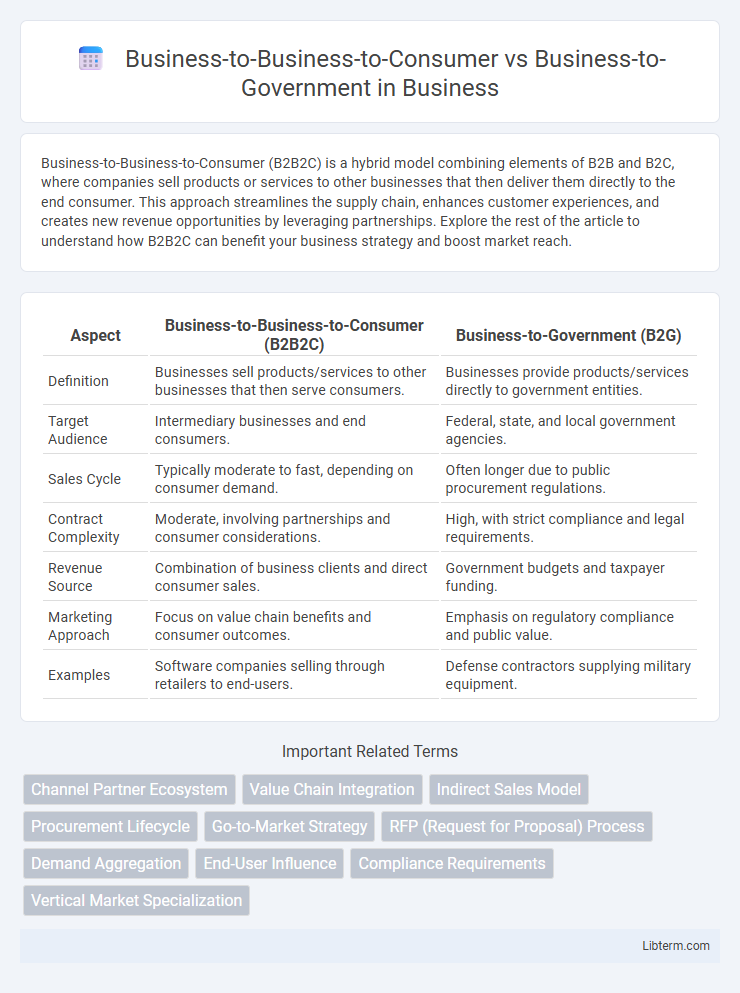Business-to-Business-to-Consumer (B2B2C) is a hybrid model combining elements of B2B and B2C, where companies sell products or services to other businesses that then deliver them directly to the end consumer. This approach streamlines the supply chain, enhances customer experiences, and creates new revenue opportunities by leveraging partnerships. Explore the rest of the article to understand how B2B2C can benefit your business strategy and boost market reach.
Table of Comparison
| Aspect | Business-to-Business-to-Consumer (B2B2C) | Business-to-Government (B2G) |
|---|---|---|
| Definition | Businesses sell products/services to other businesses that then serve consumers. | Businesses provide products/services directly to government entities. |
| Target Audience | Intermediary businesses and end consumers. | Federal, state, and local government agencies. |
| Sales Cycle | Typically moderate to fast, depending on consumer demand. | Often longer due to public procurement regulations. |
| Contract Complexity | Moderate, involving partnerships and consumer considerations. | High, with strict compliance and legal requirements. |
| Revenue Source | Combination of business clients and direct consumer sales. | Government budgets and taxpayer funding. |
| Marketing Approach | Focus on value chain benefits and consumer outcomes. | Emphasis on regulatory compliance and public value. |
| Examples | Software companies selling through retailers to end-users. | Defense contractors supplying military equipment. |
Understanding B2B2C and B2G Business Models
Understanding B2B2C and B2G business models reveals distinct market dynamics and customer engagement strategies. B2B2C combines business partners delivering products or services to end consumers, enabling companies to leverage intermediaries for wider reach and personalized consumer experiences. B2G involves businesses providing goods or services directly to government agencies, requiring compliance with regulatory frameworks and long-term contract management to navigate public sector procurement.
Key Differences Between B2B2C and B2G
Business-to-Business-to-Consumer (B2B2C) models facilitate transactions from a company through another business to the end consumer, emphasizing customer engagement and seamless integration of services. Business-to-Government (B2G) involves transactions between businesses and government entities, focusing on compliance, regulatory requirements, and often long procurement cycles. Key differences include target audience complexity, with B2B2C blending consumer preferences and business operations, whereas B2G prioritizes adherence to government standards and contract bidding processes.
Target Markets: Businesses, Consumers, and Governments
Business-to-Business-to-Consumer (B2B2C) targets a dual market by integrating business clients with end consumers, enabling companies to build brand loyalty and enhance customer experience through intermediate partners. Business-to-Government (B2G) focuses exclusively on providing goods and services to government agencies, emphasizing compliance with regulatory standards and large-scale procurement processes. The key difference lies in B2B2C's combined approach to businesses and consumers versus B2G's specialized relationship with government entities and public sector requirements.
Sales Cycles and Decision-Making Processes
Business-to-Business-to-Consumer (B2B2C) sales cycles often involve multiple stakeholders, combining both business buyers and end consumers, which leads to a moderate-length decision-making process focused on product appeal and user experience. Business-to-Government (B2G) sales cycles tend to be longer and more complex due to regulatory compliance, formal bidding procedures, and stringent contract requirements, with decision-making driven by public accountability and policy considerations. Understanding these distinctions helps tailor sales strategies to address the specific timelines and approval hierarchies unique to each model.
Regulatory and Compliance Challenges
Business-to-Business-to-Consumer (B2B2C) models navigate complex regulatory landscapes involving consumer data protection laws such as GDPR and CCPA, requiring stringent compliance across multiple parties to secure end-user privacy. In contrast, Business-to-Government (B2G) engagements demand adherence to specialized public sector regulations, including procurement rules, transparency mandates, and cybersecurity standards like FedRAMP or NIST frameworks. Both B2B2C and B2G sectors face distinct compliance challenges, with B2B2C prioritizing consumer rights enforcement and B2G emphasizing regulatory accountability and standardized reporting.
Marketing Strategies for B2B2C vs B2G
Marketing strategies for Business-to-Business-to-Consumer (B2B2C) prioritize building strong partnerships with intermediary businesses while simultaneously targeting end consumers through personalized engagement and omnichannel campaigns. In contrast, Business-to-Government (B2G) marketing focuses on navigating complex procurement processes, emphasizing compliance, transparency, and relationship-building with government officials and agencies. B2B2C requires leveraging data analytics to understand consumer behavior across the supply chain, whereas B2G demands meticulous proposal planning and adherence to regulatory frameworks.
Revenue Streams and Payment Structures
Business-to-Business-to-Consumer (B2B2C) revenue streams typically combine wholesale pricing models from business clients with consumer-based retail margins, leveraging subscription services or transactional sales for end-users. Payment structures in B2B2C often involve complex multi-party invoicing systems that integrate business accounts with consumer transactions, requiring seamless digital payment solutions. Business-to-Government (B2G) revenue streams rely heavily on contract-based procurement with fixed pricing, milestone payments, and long-term agreements governed by regulations, while payment structures emphasize compliance, invoice auditing, and government fiscal cycles.
Relationship Management in B2B2C and B2G
Business-to-Business-to-Consumer (B2B2C) relationship management centers on fostering collaboration between businesses to create seamless customer experiences, emphasizing trust and data sharing across supply chains. In contrast, Business-to-Government (B2G) relationship management requires compliance with regulatory frameworks, transparency, and long-term partnerships focused on public value and accountability. Effective B2B2C strategies leverage integrated CRM systems to align multiple stakeholders, while B2G engagement prioritizes contract management and stakeholder communication within government protocols.
Technology Integration and Digital Transformation
Business-to-Business-to-Consumer (B2B2C) models emphasize seamless technology integration to enhance consumer experience through multi-layered digital platforms, enabling real-time data sharing and personalized services. Business-to-Government (B2G) interactions prioritize compliance-driven digital transformation, focusing on secure, scalable solutions to meet regulatory standards and improve public service delivery. Both models leverage advanced technologies like AI, cloud computing, and blockchain to optimize operational efficiency and stakeholder engagement in their respective ecosystems.
Future Trends in B2B2C and B2G Marketplaces
Future trends in B2B2C marketplaces highlight the integration of AI-driven personalization and seamless omnichannel experiences to enhance customer engagement and drive revenue growth. In contrast, B2G marketplaces are shifting towards increased digital procurement platforms, emphasizing transparency, compliance, and cybersecurity to meet stringent government regulations. Both sectors are leveraging blockchain technology to improve transaction security and traceability, signaling a convergence in technological adoption despite their distinct operational priorities.
Business-to-Business-to-Consumer Infographic

 libterm.com
libterm.com